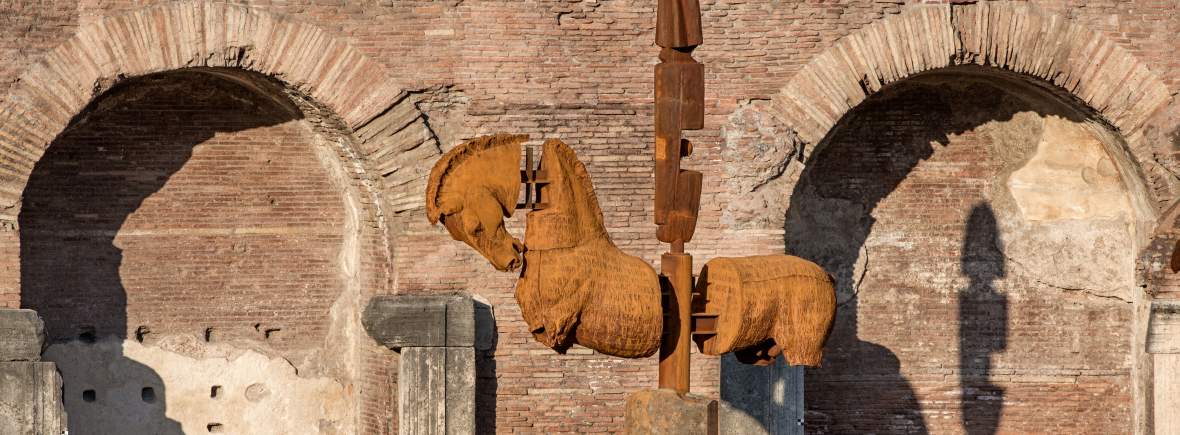Arezzo will host, from June 16 to October 14, 2018, the traveling exhibition Lapidarium: on the side of the vanquished where the statues of Mexican artist Gustavo Aceves (Mexico City, 1957) will be on display. Made of stone, bronze, resin, wood and other materials, these statues ideally recreate the wanderings of the “Quadriga of San Marco” in Venice, which had so impressed the artist when he was just 20 years old. It was the 1970s, and before being musealized in the lagoon city (in the Museum of St. Mark’s Basilica), those ancient bronze horses from Constantinople would travel one last round-the-world tour that would end the series of migrations of which they had been protagonists since the 13th century. Hence, for Aceves, the idea to give life to a work that could retrace the same itinerary made by the “Quadriga of San Marco”: his Lapidarium proposes statues dedicated to the horse, a symbol that evokes movement, displacement.
It is since 2014 that Aceves, one of the world’s leading interpreters of contemporary art, has been working on these works, which number well over 200 and will be set up in several places in Arezzo’s historic center(San Francesco, Sala Sant’Ignazio, Sagrato del Duomo, Piazza Vasari, Fortezza Medicea) to render the idea of travel and migration. As in classic museum lapidaries, where fragments of ancient works are preserved with which to reconstruct history, Aceves’ work is also characterized by the “fragment,” an element through which everyone can recover the roots of their own history.
The journey of Aceves’ horses is comparable to the journey of migrant peoples, a highly topical theme. There is also no shortage of reasons why “Lapidarium: on the side of the vanquished” marries itself to Arezzo, a city whose heraldic symbol is a horse and which entrusts to horses the celebration of its most important festival: the Saracen Joust. In addition, two important episodes are linked to the “Quadriga of St. Mark”: in 1364, it was Arezzo’s Francesco Petrarch, guest of honor at the celebrations for the submission of Candia to the Venetian Republic, who announced that the equestrian group had been transferred to the court of the Venetian doges.
Finally, the quadriga has an immediate reference to Constantine, an important figure in Aceves’ human and intellectual journey whose story finds its consecration in Arezzo, a tale frescoed by Piero della Francesca.
Gustavo Aceves (1957, Mexico City) currently lives and works in Pietrasanta, Italy. He began as a self-taught painter and more recently approached sculpture. His paintings focused on the human figure and were characterized by the use of strong colors typical of Mexican murals. Since the 1970s, his works have been exhibited around the world from the Venice Biennale to the Beijing Biennial and appear in major private and permanent collections, including the Museo de la Memoria y Tolerancia in Mexico City and the Vatican Museums. He is one of the artists offered by Christie’s and Sotheby’s auctions.
The exhibition “Lapidarium: on the side of the vanquished” is organized by the Guido d’Arezzo Foundation in collaboration with the City of Arezzo. Hours: daily from 10 a.m. to 7 p.m. Closed Mondays. Ticket price: €3. Free admission for children under 12 years old. Tickets can be purchased at the Sant’Ignazio and Fortezza Medicea exhibition venues or at the Info Point in Piazza della Libertà, 1. For all information you can call 0575-356203, visit www.arezzoaceves.wordpress.com or visit the Facebook page.
 |
| Lapidarium: the horses of Gustavo Aceves arrive in Arezzo. |
Warning: the translation into English of the original Italian article was created using automatic tools. We undertake to review all articles, but we do not guarantee the total absence of inaccuracies in the translation due to the program. You can find the original by clicking on the ITA button. If you find any mistake,please contact us.